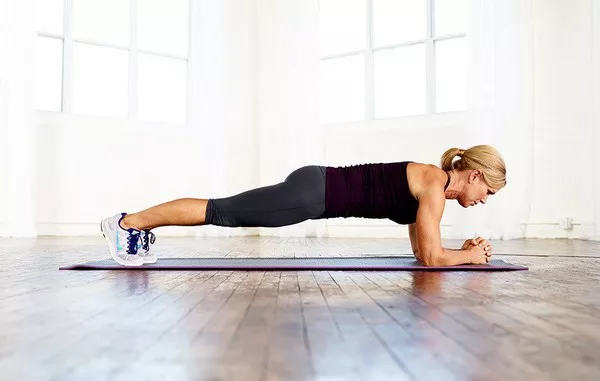If you’re looking to strengthen your back but don’t have access to dumbbells, consider the inverted row. This bodyweight exercise requires you to lie beneath a horizontal bar, maintain a rigid body position, and pull yourself toward the bar. It’s a powerful way to target your upper-body pulling muscles while engaging your core. Inverted rows help build functional strength useful for daily tasks like walking an energetic dog or pushing open a heavy door.
According to Evan Williams, CSCS, CPT, founder of E2G Performance and strength coach for the Milwaukee Bucks, inverted rows are a core movement in both recreational and professional training programs. “It’s a great alternative to the traditional pull-up,” Williams tells SELF. Unlike the pull-up—a more advanced movement—the inverted row can be modified to suit different fitness levels, making it an accessible entry point for many exercisers.
Here’s everything you need to know about this highly effective exercise, including the muscles it targets, how it compares to pull-ups, alternatives to the movement, and tips for doing it at home.
What Muscles Do Inverted Rows Work?
The primary muscle activated during an inverted row is the latissimus dorsi—the broadest muscle in the back. Williams notes that you’ll also work your rhomboids and trapezius muscles, both located in the upper back and involved in scapular movement. Additionally, your biceps assist in the pulling motion, and your core muscles engage to stabilize the body throughout the exercise.
Are Inverted Rows Better Than Pull-Ups?
Inverted rows and pull-ups target similar muscle groups, but they offer different types of movement and challenges. Inverted rows focus on horizontal pulling strength and power, which is useful in activities like pulling a dog leash or opening a heavy door. Pull-ups, on the other hand, build vertical pulling strength, aiding in actions like rope climbing or scaling walls.
While pull-ups generally demand more from the upper body—as you’re lifting your full bodyweight—inverted rows are easier to adjust. Modifications such as bending your knees, widening your foot stance, or raising the bar height reduce resistance, making the move ideal for beginners. Williams notes that inverted rows are often a key component of progressive pull-up training programs.
Moreover, inverted rows offer flexibility in execution. They can be performed using a variety of setups: parallel bars, Smith machines, suspension trainers, or even sturdy household objects like tables, chairs, or towels. This accessibility makes them especially valuable for at-home workouts, whereas pull-ups typically require a dedicated pull-up bar.
Is the Inverted Row the Same as the Australian Pull-Up?
Yes—the terms “inverted row,” “Australian pull-up,” and “bodyweight row” all refer to the same movement. Regardless of the name, the mechanics and muscle engagement remain the same.
What Are the Best Inverted Row Alternatives?
If you don’t have access to a bar setup, you can still perform variations of the inverted row:
Suspension Trainers (e.g., TRX Rows): These allow for scalable difficulty and a similar pulling motion.
Household Setups: Use a sturdy table or two strong chairs and a broomstick or dowel to create a DIY bar.
Towel Rows: Loop a towel over a secure bar or frame and perform bodyweight rows while holding both ends.
Partner Rows: Sit on the floor while a partner extends their hands. Grip their hands and pull yourself up, simulating the row motion.
How to Do an Inverted Row at Home
Mini parallel bars (parallettes) are a great tool for inverted rows outside the gym. Williams recommends performing 5 to 10 repetitions for 2 to 3 sets. You can include this move in a back-focused workout or as part of a full-body strength routine.
Ready to try it? Follow these step-by-step guides for both the standard and beginner versions:
Traditional Inverted Row (Legs Straight)
Lie beneath a set of parallel bars, gripping each bar with your hands in a neutral position (palms facing each other).
Keep your wrists aligned with your chest, arms extended, and legs straight with heels on the ground.
Engage your core and retract your shoulder blades.
Pull your chest toward the bars by bending your elbows while maintaining a rigid body.
Pause when your head reaches bar height, then slowly lower back to the starting position.
Modified Inverted Row (Knees Bent)
Set up the same way as the traditional row, but bend your knees and keep your feet flat on the ground.
Engage your core and pull your body toward the bars.
Pause briefly at the top, then return to the start position in a controlled manner.
The moves above are demonstrated by Landyn Pan, a fitness and nutrition coach who specializes in inclusive training for LGBTQ+ clients.
Final Thoughts
Inverted rows are an excellent option for anyone looking to build back and bicep strength without needing a full gym setup. Their adaptability, combined with the functional strength benefits, make them a staple for beginners and advanced athletes alike. Whether you’re working out at home or in the gym, this simple bodyweight move can help you improve posture, core stability, and upper-body pulling power.
For more expert-backed fitness content, sign up for SELF’s newsletter to get tips and workout plans delivered straight to your inbox.
Related Topics



































